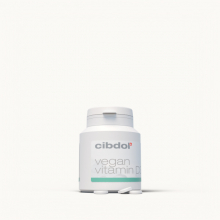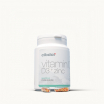How long does it take for vitamin D levels to increase?
Published:
Vitamin D is essential for bone health and many other aspects of your health. If you've been diagnosed with a vitamin D deficiency, you may be wondering how long it will take to restore your levels.
Contents:
- Why Does Vitamin D Matter?
- How Long Does It Take to Increase Vitamin D Levels?
- Dosage Needed to Increase Vitamin D
- How Do Vitamin D2 vs D3 Supplements Compare?
- When Will I Start to Feel the Effects?
- Summary of Key Points:
- Q: How long does it take for vitamin D levels to increase?
- Q: What is vitamin D deficiency?
- Q: How can I treat vitamin D deficiency?
- Q: What are the symptoms of vitamin D deficiency?
- Q: How much vitamin D should I take daily?
- Q: What are the dietary sources of vitamin D?
- Q: How quickly can vitamin D levels increase with supplementation?
- Q: How can I raise my vitamin D levels quickly?
- Q: How much vitamin D is too much?
- Q: What is the definition of vitamin D deficiency?
- Resources used to write this article
This article will cover everything you need to know about how long it takes vitamin D supplementation to increase vitamin D levels in your blood. We'll discuss the factors that affect how quickly your levels rise, optimal dosage, types of vitamin D supplements, and what to expect once you begin treatment. You'll learn how to work with your doctor to monitor your levels and meet your vitamin D goals.

Why Does Vitamin D Matter?
Vitamin D plays an important role in calcium absorption and promoting bone growth. It also supports muscle and nerve function, a healthy immune system, and cardiovascular health. Our bodies synthesize vitamin D from sunlight exposure. Vitamin D can also be obtained from foods like fatty fish, eggs, and fortified milk and cereals.
However, many people have low levels of vitamin D. Deficiency is estimated to affect nearly 1 billion people worldwide. The most common causes are lack of sun exposure, darker skin tones, living in northern latitudes, being overweight, and certain medical conditions.
Symptoms of vitamin D deficiency can include frequent illness, muscle weakness, bone loss, bone fractures, and chronic pain. Restoring healthy vitamin D levels through diet, sunshine, and supplementation can prevent these negative effects on your health.
How Long Does It Take to Increase Vitamin D Levels?
The time needed to increase vitamin D levels depends on several factors:
- Your starting vitamin D level
- The dosage and type of supplement you take
- How consistently you take vitamin D supplements
- Your body's ability to absorb and use vitamin D
In general, most healthy adults can raise their vitamin D level by 10-20 ng/mL in 2-3 months with proper supplementation. Reaching optimal levels around 50 ng/mL may take 3-6 months. Those with severe deficiency may need up to a year to reach ideal values.
Your doctor can check your vitamin D blood level, also known as 25(OH)D or serum vitamin D, to determine your starting point. Optimal blood levels are between 50-80 ng/mL, while deficiency is commonly defined as anything under 30 ng/mL.
Dosage Needed to Increase Vitamin D
The dosage of vitamin D needed to raise your levels will depend on your individual needs and requirements.
The National Institutes of Health recommends 600-800 IU of vitamin D per day for adults to maintain bone health. Higher doses of 1,000-4,000 IU per day are often used to correct a deficiency.
Your doctor may prescribe even higher doses around 50,000 IU per week or 10,000 IU per day for those with very low blood levels. The maximum upper limit is 4,000 IU for children over 9 years and 10,000 IU for adults per day.
While high-dose vitamin D treatment may help raise levels faster, lower daily doses are likely safer for long-term supplementation. Your doctor can help determine the optimal dosage for your needs between 1,000-4,000 IU daily.
How Do Vitamin D2 vs D3 Supplements Compare?
The two main forms of supplemental vitamin D are:
- Vitamin D2 (ergocalciferol): Derived from plant sources
- Vitamin D3 (cholecalciferol): Derived from animal sources and produced in the skin from sun exposure
Research shows vitamin D3 raises vitamin D levels significantly more than vitamin D2. D3 also remains active in the body for a longer time.
For these reasons, most doctors recommend vitamin D3 over D2 for correcting deficiency. D3 supplements are widely available and come in tablets, capsules, powders, and liquid drops.
When Will I Start to Feel the Effects?
You may start to feel better within 1 month of starting vitamin D treatment, but full recovery can take 3-5 months.
Some of the first effects you may notice include:
- Increased energy levels
- Improved mood
- Reduced pain and muscle cramps
- Better immune function and fewer illnesses
As your levels continue to rise, you'll fully restore your bone strength, muscle function, and protection against various diseases. Be patient, stick with your treatment plan, and work with your doctor to track your levels every 3-4 months.
Summary of Key Points:
- It typically takes 2-3 months to raise vitamin D levels by 10-20 ng/mL with proper supplementation.
- Optimal daily vitamin D intake is 600-4,000 IU. Those with severe deficiency may temporarily require doses as high as 50,000 IU per week.
- Vitamin D3 is more effective at increasing levels than vitamin D2.
- You may start to feel better within 1 month but allow 3-6 months to fully correct deficiency.
- Check your levels every 3-4 months and adjust your dosage as needed to meet your vitamin D goals. Be patient - restoring healthy levels is a safe, simple process!
The time needed to improve your vitamin D status depends on many factors, but proper supplementation can correct deficiency in just a few months. Work closely with your doctor, get your levels tested regularly, and take your vitamin D as directed. With this approach, you can safely raise your levels, improve your health, and feel your best!
Q: How long does it take for vitamin D levels to increase?
A: The time it takes for vitamin D levels to increase can vary depending on several factors, including your current vitamin D status, how much sunlight exposure you get, and your overall health. In general, it can take several weeks to months for your vitamin D levels to increase significantly.
Q: What is vitamin D deficiency?
A: Vitamin D deficiency refers to a condition where the body does not have enough vitamin D to function properly. This can happen due to insufficient sunlight exposure, inadequate dietary intake, or problems with the body's ability to absorb vitamin D.
Q: How can I treat vitamin D deficiency?
A: Vitamin D deficiency can be treated by increasing your intake of vitamin D through sunlight exposure, dietary sources, or supplements. Your healthcare provider can help determine the appropriate treatment plan based on your individual needs.
Q: What are the symptoms of vitamin D deficiency?
A: Symptoms of vitamin D deficiency can vary but may include fatigue, muscle weakness, bone pain, depression, and weakened immune function. However, some people with vitamin D deficiency may not experience any noticeable symptoms.
Q: How much vitamin D should I take daily?
A: The recommended daily intake of vitamin D varies depending on age, sex, and health status. In general, adults need about 600-800 international units (IU) of vitamin D per day. However, it is best to consult with your healthcare provider to determine the appropriate dosage for your specific needs.
Q: What are the dietary sources of vitamin D?
A: Some dietary sources of vitamin D include fatty fish (such as salmon and mackerel), fortified dairy products, egg yolks, and some mushrooms. However, it can be difficult to obtain enough vitamin D from food alone, which is why sunlight exposure and supplementation are often recommended.
Q: How quickly can vitamin D levels increase with supplementation?
A: With proper supplementation, vitamin D levels can start to increase within a few weeks. However, it may take several months of consistent supplementation to reach optimal vitamin D levels.
Q: How can I raise my vitamin D levels quickly?
A: To raise your vitamin D levels quickly, you can try increasing your sunlight exposure, consuming vitamin D-rich foods, and taking vitamin D supplements as recommended by your healthcare provider.
Q: How much vitamin D is too much?
A: While vitamin D is important for overall health, excessive intake can lead to vitamin D toxicity. The safe upper limit for vitamin D intake is generally considered to be 4,000-10,000 IU per day, depending on age and health status. It is best to consult with your healthcare provider before taking high-dose vitamin D supplements.
Q: What is the definition of vitamin D deficiency?
A: Vitamin D deficiency is defined as having blood levels of vitamin D below the optimal range, which is typically considered to be between 30-50 nanograms per milliliter (ng/mL). However, the specific cutoffs for deficiency may vary depending on the reference range used by different laboratories.
Resources used to write this article
National Institutes of Health Office of Dietary Supplements. (2021, March 22). Vitamin D. Retrieved from https://ods.od.nih.gov/factsheets/VitaminD-HealthProfessional/
The National Institutes of Health: Office of Dietary Supplements. (2016). Vitamin D Fact Sheet for Health Professionals. Retrieved from https://ods.od.nih.gov/factsheets/VitaminD-HealthProfessional/
EFSA Panel on Dietetic Products, Nutrition and Allergies. (2016). Dietary reference values for vitamin D. EFSA Journal, 14(10), e04547. https://efsa.onlinelibrary.wiley.com/doi/epdf/10.2903/j.efsa.2016.4547
Holick, M.F. (2007). Vitamin D Deficiency. New England Journal of Medicine, 357(3), 266–281. https://doi.org/10.1056/nejmra070553
Kennel, K. A., Drake, M. T., & Hurley, D. L. (2010). Vitamin D Deficiency in Adults: When to Test and How to Treat. Mayo Clinic Proceedings, 85(8), 752–758. https://doi.org/10.4065/mcp.2010.0138
Martineau, A. R., Jolliffe, D. A., Hooper, R. L., Greenberg, L., Aloia, J. F., Bergman, P., Dubnov-Raz, G., Esposito, S., Ganmaa, D., Ginde, A. A., Goodall, E. C., Grant, C. C., Griffiths, C. J., Janssens, W., Laaksi, I., Manaseki-Holland, S., Mauger, D., Murdoch, D. R., Neale, R., ... Camargo, C. A., Jr (2017). Vitamin D supplementation to prevent acute respiratory tract infections: Systematic review and meta-analysis of individual participant data. BMJ (Clinical research ed.), 356, i6583. https://doi.org/10.1136/bmj.i6583
Tripkovic, L., Lambert, H., Hart, K., Smith, C. P., Bucca, G., Penson, S., Chope, G., Hyppönen, E., Berry, J., Vieth, R., & Lanham-New, S. (2012). Comparison of vitamin D2 and vitamin D3 supplementation in raising serum 25-hydroxyvitamin D status: A systematic review and meta-analysis. The American Journal of Clinical Nutrition, 95(6), 1357–1364. https://doi.org/10.3945/ajcn.111.031070











